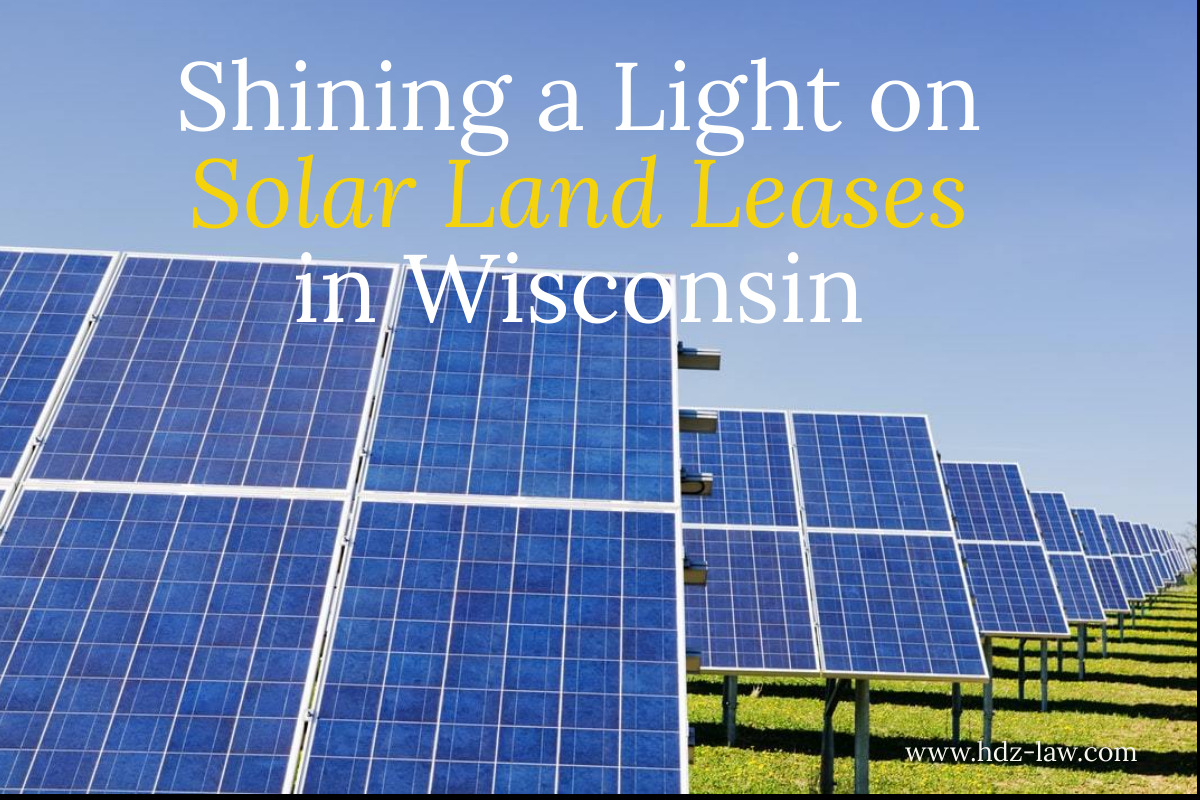
While it is hard to imagine the “frozen tundra” as a state with enough sunshine to warrant a large market for solar panel projects (“Projects”), the already growing clean energy movement in the U.S. could soon see a boost in funding and tax credits. Therefore, Projects are likely to spring up in Wisconsin more frequently, and with enough acres, optimal collection sites and a well negotiated land solar lease (“Lease”), Wisconsin landowners, and particularly farmers, could have a bright opportunity on the horizon.
The Process
With medium to large scale Projects, developers contact landowners on adjoining properties to create a grid of solar panels big enough to be profitable for both the developers and energy companies to invest in that Project. Instead of purchasing land all across the country, Project developers enter into long term Leases typically between thirty and fifty years.
The first step for a developer is to have a surveyor/consultant determine areas and municipalities with enough available vacant property to support a Project. This is why farmers are often contacted, as they have acres of cleared and usually fairly flat land. If enough adjacent or nearby property owners can agree and get a consensus to move forward in negotiating a Lease, the developer will submit a proposal and draft of the Lease. While each landowner will sign a separate Lease with the developer with the unique specifics of their land, the main structure of the Lease will remain consistent between all landowners within any given Project. Therefore, the adjacent landowners can benefit from costs of scale by banding together to engage an attorney to negotiate the Lease.
Once the Lease is executed, the option period of the Lease begins and the landowner receives an initial payment. This option period usually allows for a window of a couple of years for the developer to perform due diligence, which includes: (i) performing weather, soil, light, etc. testing that will allow them to find the most effective area/areas of the land under the Lease for the solar panels to be constructed; (ii) working with the applicable municipalities to ensure support of the Project and to secure proper zoning; and (iii) securing a contract with the related electric company to sell the energy collected from the solar panels. This time also allows for the landowner to (i) continue to use their property until the final amount of land under the Lease, if any, is determined by the developer; and (ii) be paid for allowing the developer access to run the necessary tests and analysis.
Lastly, once the developer determines the final amount of land to be covered under the Lease, the developer exercises their option to begin the Lease, at which time the option period payments are replaced with annual Lease term payments.
Considerations
While this type of Lease, if carried to fruition, can lead to a long-term steady stream of income to landowners, it is important to understand what a long-term Lease can mean for the landowner.
First, one must determine what payment amount will make it worth potentially tying up a significant portion of their property for several decades. When negotiating the Lease, it is important for the landowner to understand the minimum amount of acreage that they need to be paid for to keep not only the leased land under access and use restrictions, but also the landowner’s property immediately surrounding the leased area, which will likely have restrictions on what can be built or grown so as to not interfere with access to sunlight. Are you fine with potentially not being able to farm or build on the surrounding property of the leased land? What payment amount would you need on an annual basis to recoup that loss of use?
Second, while the push for and acceptance of clean energy Projects are on the rise, it is important to understand that all your neighbors or your municipality may not be on board for this new-aged energy farming. The more neighboring properties that can come together as part of the Project, the more likely their voices will be heard and the community will get behind their residents.
Third, it is important to plan for the future and what happens if the Lease is terminated or eventually runs its course. Landowners should look to include provisions in the Lease to cover the costs of the decommissioning and removal of the solar panels to restore the land.
Every landowner’s property and situation is unique, and every landowner considering a solar lease needs to fully understand the ramifications of such lease. Therefore, it is important to speak with an attorney knowledgeable about solar leases, so they can help light the path to a successful long-term revenue stream.
For more questions regarding Solar Land Leases, call Katrina Cox at 920-430-1900.
